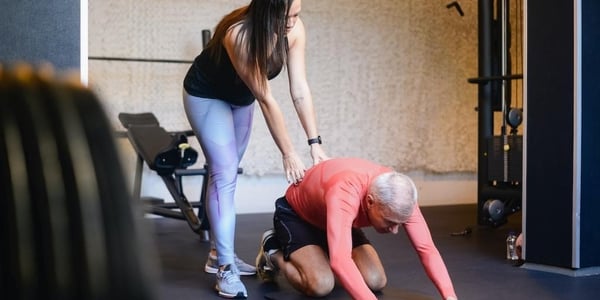Finding the time and motivation to exercise regularly can be a challenge. The thought of committing...


Finding the time and motivation to exercise regularly can be a challenge. The thought of committing...
As we age, the quest for ways to maintain health, vitality, and overall well-being becomes...

As we pass the milestone of 50, many of us begin to wonder how well we're aging. Aging is an...

It's never too late to start or restart your fitness journey. As we reach age 50 and beyond,...
13 Helpful Tips for Continuing Your Hobbies With Arthritis
Living with arthritis can pose significant challenges, especially when it comes to maintaining the activities and hobbies you love. With arthritis comes pain, stiffness, and reduced mobility, which can hinder your ability to engage in hobbies that require fine motor skills, physical exertion, or long periods of activity. However, this doesn't mean you have to give up on your interests. In fact, continuing to participate in your hobbies can be a highly beneficial part of managing your arthritis physically and mentally. In this blog, we’ll provide strategies to help you keep enjoying your hobbies despite arthritis.
Find What Works for You
Navigating life with arthritis often means finding new ways to engage in the hobbies you love without exacerbating your symptoms.
Adapt Your Approach
It's important to recognize that while your enthusiasm for your hobbies remains unchanged, your approach to them might need some adjustments. Consider how you can modify your activities to put less stress on your joints. For example, if you enjoy gardening, using ergonomically designed tools can help reduce strain. Raised garden beds and kneeler seats are also excellent for reducing the need to bend down or kneel.
Take Frequent Breaks
Arthritis often requires you to listen more closely to your body and recognize when to take breaks. Breaking down activities into smaller, manageable tasks can help prevent fatigue and joint stress. If you're into DIY projects or crafting, try to work in shorter intervals and take frequent breaks to rest your hands and joints. Pacing is crucial to ensure that you don't overexert yourself.
Update Your Workspace and Materials
Modifying your workspace and using the right tools can significantly enhance your ability to continue enjoying your hobbies.
Use Good Lighting
Proper lighting is crucial, especially for hobbies that require precision, like sewing or model building. Good lighting can help you see better and reduce eye strain, which is prominent because discomfort in one area can lead to compensating movements that might stress your joints. Consider adjustable lamps that you can direct exactly where you need the light most.
Stay Organized
Keeping your workspace tidy and your tools within easy reach can significantly reduce unnecessary movements and strain. Store your materials in clear, labeled containers so you can find everything quickly and easily. An organized space helps physically and reduces stress, making your hobby more enjoyable.
Use Adaptive Equipment
A wide range of adaptive tools and devices are designed to make activities easier for those with limited mobility or joint pain. For example, if you enjoy reading or crafting, look for holders that can keep your book or materials at a comfortable angle, reducing the need to hold them up yourself.
Lighten the Load
If your hobby involves carrying heavy items, such as photography gear or craft supplies, opt for lighter alternatives or supportive aids like carts. Lightweight equipment and tools that reduce physical strain can help protect your joints. These adaptations protect your joints and can extend the duration of your hobby activities.
Embrace a New Mindset
A positive mindset and flexibility in how you approach your hobbies are pivotal to enjoying them despite the challenges of arthritis.
Stay Positive and Be Flexible
Maintaining a positive outlook is crucial when dealing with chronic conditions like arthritis. Being flexible and open to change can help you adjust to new ways of enjoying your hobbies more easily. Try your best to be patient with yourself and celebrate the small victories, like a successful adaptation to a tool or a new hobby that brings you joy.
Focus on What You Can Do
It can be helpful to focus on activities that you can do comfortably rather than on those that are now too challenging. For example, if knitting has become too difficult, you could switch to loom knitting, which can be easier on the hands. The key is to find alternatives that allow you to enjoy the essence of your hobby without the pain.
Take Care of Yourself
Improving your physical health through lifestyle adjustments is crucial for managing arthritis and enhancing your hobby experience.
Incorporate Physical or Occupational Therapy Exercises
Incorporating exercises recommended by a physical or occupational therapist into your routine can strengthen the muscles around your joints, increasing mobility and reducing pain. These exercises can be tailored to your specific needs and incorporated into your hobby time. For example, if you like swimming, specific water exercises can be both therapeutic and enjoyable.
Exercise Regularly
Incorporating regular physical activity is crucial for managing arthritis. Exercises like swimming, cycling, and walking are low-impact yet effective in strengthening muscles around your joints and increasing flexibility. Regular exercise can decrease joint pain, making it easier to engage in your hobbies. If you aren’t already, consider adding stretching, strength training, and aerobic exercises into your routine.
Maintain a Healthy Lifestyle
Supporting your hobbies with a healthy lifestyle can enhance your ability to manage arthritis. A balanced diet rich in anti-inflammatory foods, adequate hydration, proper sleep, and avoiding smoking or excessive alcohol consumption can all contribute to better overall health and improved symptom management.
Ask for Help
Seeking professional guidance and connecting with a community of fellow hobbyists can provide you with the support and ideas needed to adapt your hobbies around your arthritis.
Seek Professional Guidance
A physical therapist can offer personalized advice on maintaining your hobby activities in ways that suit your specific situation. They can suggest exercises to strengthen the muscles around your joints, improving your ability to perform your favorite tasks.
Find Community and Support
Joining a group of people who share your hobby can provide emotional support and practical tips for dealing with arthritis. Whether it’s an online forum, a local club, or a class, connecting with others can offer motivation and new ideas for adaptation. Sometimes, simply sharing your experiences with others who understand can be incredibly uplifting and informative.
Click here or the button below to open a TopLine Financial Credit Union certificate!
10 Arthritis-Friendly Hobbies
Hobbies that encourage gentle movements and flexibility can help manage arthritis symptoms effectively and improve overall well-being. If you have arthritis and are looking for a new hobby, here are ten great arthritis-friendly hobbies to consider:
*It’s a good idea to consult with a healthcare provider before starting new physical activities to ensure that they are safe and beneficial for your specific health circumstances.
Developing arthritis doesn't have to mark the end of your engagement with hobbies and passions. Through creativity, adaptation, and support, you can enjoy a fulfilling and active life, even with arthritis. Remember, the goal is to find balance and techniques that allow you to continue the activities you love without worsening your symptoms. Embrace the changes, and let your hobbies bring you joy in new and adapted ways.
Click here or the button below to find a Medicare Insurance plan with TopLine Financial Credit that fits your needs.
Living50+